| Release List | Coupons | Shop | Reviews | SUBSCRIBE | Forum | Video Games | Price Search | Advertise |
| DVD & MOVIE REVIEWS |
|
|
| DVD TALK FORUM |
| REVIEWS & COLUMNS |
|
• DVD Reviews • Theatrical Reviews • Video Game Reviews • Adult DVD Reviews • DVD Interviews • The Aisle View • The Blue Room • Cinema Gotham • CineSchlock-O-Rama • DVD Savant
|
| SHOP |
|
• Adult DVD Empire • Amazon.com (DVD) • Buy.com • DeepDiscountCD • DeepDiscountDVD • DVD Empire • DVD Overnight • DVD Planet • Ebay • Half.com • HKFlix.com • HTMarket.com • Complete List of Stores |
| DVD RESOURCE |
|
• DVD Talk Forum • DVD Price Search • Store Ratings • Customer Service #'s • DVD FAQ • Regional Encoding Info • Search Toolbar • Links |
| DVDTALK INFO |
|
• About DVD Talk • Advertise • Contribute • Tell A Friend • Newsletter Subscribe • Join DVD Talk Forum |
 |
IT'S A WONDERFUL LIFE - or: It's A Wonderful Recut?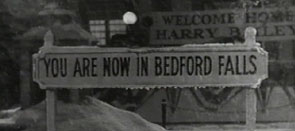
--- Was everyone's favorite Christmas film an editorial save-job?
While watching It's a Wonderful Life for the umpteenth time, I saw a detail I never noticed before in dozens of showings. After thinking about the implications of this new 'detail', Savant now believes it possible that the entire flashback structure of that film was imposed during post production, in a desperate attempt to save a movie that wasn't working. A flashback structure, to be perfectly clear, is the separation of scenes that are supposed to be occurring in the present tense, from those that happened 'before the movie began'. This film begins on Christmas Eve and ends just a few hours later, but over 90 minutes are spent revisiting events in leading character George Bailey's past. Most flashbacks are presented as memories or personal testimony (Citizen Kane, Invasion of the Body Snatchers). It's a Wonderful Life's are omniscient views from George's past shown to Angel Second Class Clarence Oddbody, as if being played back on some kind of heavenly VCR. It is well documented that Invasion of the Body Snatchers had a flashback 'wraparound' imposed on it that muted the fatality of its message. Going back to the dawn of movies, it is interesting to note that the same was done with The Cabinet of Dr. Caligari (1919), changing that film's politics from anarchic protest to conservative reassurance. I hope to show evidence for the theory that It's a Wonderful Life's flashback structure was a brilliant editorial rescue to save what Capra and star James Stewart feared was a total failure. In his autobiography, Frank Capra describes the filming of It's a Wonderful Life as pure torture. There is even a photo from the set where Capra and James Stewart seem on the brink of despair. Capra didn't write specifically what the problems were, which made me curious, especially considering how splendid their 'tortured' movie eventually came out. And Capra's memories are so full of exclusions (he barely credits the writers of his great pictures) and mythmaking (does he really expect us to believe he tossed the first reel of Lost Horizon into a furnace?) that I'm not sure I'd trust his version of events anyway. For a man who rarely admited professional problems, Capra's account of acute anxiety while making what became his most beloved film raised my curiosity. 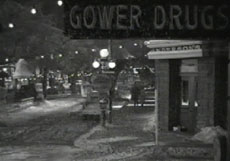 before the entrance of the 'running man'. AN EDITORIAL CLUE. The telltale detail occurs right at the beginning. Unseen people pray for George Bailey as we are shown a selection of views of a snowy Bedford Falls. In one of them, a view right down the middle of main street, a figure appears deep in the center background, running toward us. The camera cuts away just before we fully notice him. He doesn't make much of an impact, until you look at the shot again and realize that the little running man is James Stewart. 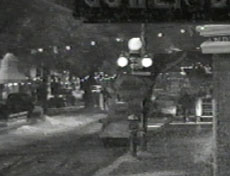 - it's James Stewart! Apparently, the shot was filmed for the scene much later in the film where George Bailey runs down the center of Main Street yelling 'Merry Christmas Bedford Falls!' and the like. It looks like an unused angle where George is meant to wave and yell 'Merry Christmas' at the building to his right. Okay, so the editors used a piece of film meant to be seen elsewhere in the picture. This was Capra's first independent production, money was tight, and his editors made creative use of film that would normally be thrown away. So what? What if that entire opening sequence, indeed, the entire flashback framework, had been invented in the editing room and designed as cheaply as possible, scavenging every useful piece of leftover trim available? What if the flashback structure, with the angel Clarence being briefed on George's life, was the 'save' imposed on a film that wasn't working? Savant believes It's a Wonderful Life was originally shot and assembled in simple chronological order. This was likely the format of the extended Christmas card that served as the inspiration for the movie. I think we were originally meant to learn about Bailey's life as a straight narrative from his childhood ice accident through his romance and the war up to the very fateful Christmas Eve where he considers suicide. Only then were we to meet Clarence, at the same time Bailey does. If you can imagine the movie playing as a straight narrative, you can see the problems it would impose on the story structure. Picture Capra squirming through his assemblage of ninety expository minutes of Stewart's adventures as a child and young man, realizing that it is all basically directionless. Suddenly, when Clarence the Angel drops in out of nowhere, Life becomes a cockeyed fantasy. An audience concentrating on the earlier scenes of George's fairly realistic and believable problems, would be taken totally off guard by the sudden addition of a fantasy element. A resentment factor can kick in when an audience has waited patiently for one story to shape up, and the movie suddenly takes a brand-new tangent inconsistent with what has gone before. If the tone changes radically the audience won't follow, and may in fact resent the whole show. This audience-resistance effect cripples the modern movie Prelude to a Kiss, in which a light romance suddenly decides it is a strange fantasy halfway through the film and without warning. Savant theorizes that Capra realized this was happening, and his agony must have been over how to make the film work when the budget had no more money for reshoots. The heroes were the editors, of course. They made possible a complete reorganization of It's a Wonderful Life, introducing from the very beginning the whimsical fantasy element and the crucial threat of suicide. Using the device of an Angel observing from heaven makes George's biography watchable because the viewer is told with Clarence that every detail is important. Besides adding humor to assure us that things will turn out well, the structure provides an interest 'hook' as we search the past for clues as to why George is now considering suicide. Ninety minutes in, when the back story catches up with the 'present', the Angels release us from the flashback and the rest of the tale plays out in real time. When Clarence shows up, it's like meeting an old friend whose face we've never seen. THE EDITORIAL EVIDENCE TO BACK UP THIS CRAZY CLAIM The little piece of film with James Stewart in the background is only the tip of the iceberg of editorial evidence, so to speak. A cataloging of the shots comprising the flashback wraparound material shows two things: 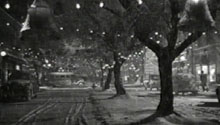 First, almost all the live action in the opening montage seems to have been salvaged from trims. Every shot of snowy Bedford Falls is probably a part of the head trim between the slate and the director's 'Action!' command. The fact that Capra had to cobble together bits of establishing shots to make a 'snow falls on the town' montage, tells Savant that the need for the footage wasn't perceived until after his expensive snowy street set was struck and shooting finished. It seems very likely that the scene was 'invented in post.' In the entire montage, the only (partial) live action scene that doesn't appear to be an editorial trim is the beautiful house pullback matte painting (It's the image at the bottom of this page). It certainly doesn't look cheap! If it wasn't commissioned especially for the flashback wraparound, perhaps it was moved from elsewhere in the picture. Was it the original last shot of the film? Second, most of the other elements of the flashback wraparound were relatively inexpensive to put together. Only actors' voices were used, radio-style. We don't see George's neighbors or wife and children praying, we merely hear them. Heaven is represented by a little animation of blinking stars and planets. A blurry point of view is optically added to represent Clarence's 'learning' to see the heavenly 'rerun' of scenes from George's childhood. The first time we see James Stewart as George Bailey his gesture imagining a big suitcase is frozen-framed, so that time can be alotted for Clarence's voiceover to assess the now grown-up boy whose life he has been watching. 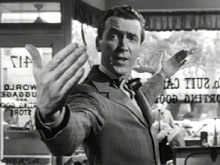 A director friend of mine liked my theory but asked why the entire mystery couldn't be straightened out by a simple look at the original shooting script for the movie. Savant hasn't been able to locate one. The published scripts for the film are all continuity scripts that merely document the finished film, after the fact. And the 'original shooting script' in the otherwise thorough making-of book turns out to be the same continuity script anyone could have transcribed from the feature film. Contradicting itself, the book calls it an 'as-produced' script on its title page, a clue that the original script might have been withdrawn just before publication. The making-of book doesn't mention anything about the final creation of the film's flashback structure, or when it was imposed. But it does document the fact that there was great indecision before shooting as to what structure to give Life, and details Capra's unwillingness to commit to a flashback wraparound structure. The 'heavenly fantasy' subgenre (now sometimes referred to as 'film blanc'! 1) was very popular in the years just preceding, and the book states that Capra had no interest in repeating the cliches of Heaven Can Wait, A Guy Named Joe, Here Comes Mr. Jordan, and A Matter of Life and Death. His own Lost Horizon had a similar flashback wraparound, and Capra rejected anything similar, including one 'heavenly waiting room' concept described in the making-of book. But the book offers no clue as to how Capra solved the problem. Savant believes Capra was so overwhelmed by the first-time chore of simultaneously producing, financing, directing and writing that he started filming, and possibly finished filming, without ever making a final decision. Yes, all it will take to support or shoot down this theory is some real research access to an original 1946 shooting script. Like many another so-called 'mystery', Savant still considers this theory a good one to include here because it demonstrates that in figuring out things about movies, more often than not the best research is simple observation of the movies themselves. The next time you see It's a Wonderful Life, look for the shot in the beginning where Stewart starts to run. Would perfectionist Capra have left the shot in there if he didn't have to?
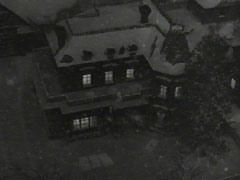
1. It's a Wonderful Life is unique in that it is a Film Blanc with a self-contained Film Noir episode. The horror vision of Bedford Falls turned into the degenerate Pottersville is like an alternate-universe in a time travel science fiction story. What Savant hasn't heard pointed out elsewhere is that this must have been Capra's statement against the violent, amoral 40s thrillers he so vociferously condemned in his autobiography, films like Kiss of Death where grandmothers in wheelchairs are pushed to their deaths down stairways. Kiss of Death and its ilk, of course, would eventually come to be known as Film Noir. Read more about Films Blanc in a related Savant article. Text © Copyright 1998 Glenn Erickson.
DVD Savant Text © Copyright 1997-2001 Glenn Erickson
|
| Coming Soon |
|
|
| Special Offers |
|
|
| Columns |
| Home | Release List | Coupons | Shop | Reviews | Forum | Video Games | Price Search | Advertise |





